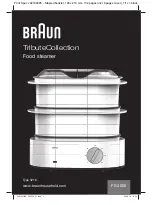
45
44
Smart Programmes: Non Air Frying
Smart Programmes: Non Air Frying
10.
The cooker beeps once the water temperature is reached. Remove the lid and
immerse the sealed pouches in the warm water. The pouches contents should
be submerged, but the seal should remain above the water line.
11.
Place and close the lid as described in
Pressure Control Features — Pressure
Note:
For cooking times over
04:00
hours, check the water level periodically to ensure
pouch contents remain submerged. If required, add heated water to the inner pot.
12.
Once complete, the display indicates
End
. Open cooker and carefully remove
the pouches from water.
13.
Remove contents from pouches and use a thermometer to check for
doneness. Follow a recipe or refer to the
Reverse Searing
Searing your meat after cooking, rather than before, is a great way to boost flavors.
After sous vide cooking, remove the meat from the cooking pouch and gently pat
it dry. Then, sear it lightly in the inner pot with the Sauté Smart Programme, or use
a pan, blow torch or grill.
Ingredients and Seasonings
• Use high quality, fresh ingredients when cooking sous vide to ensure
the best possible flavour.
• When seasoning with salt, it is better to use less than you might add
normally, especially with meats, poultry and fish. Instead, add salt to
taste after cooking.
• Use garlic powder rather than raw garlic. Raw garlic can become bitter
and overpowering when cooked sous vide. Pure and high-quality garlic
powder provides the best results.
Note:
Do not use garlic salt in place of garlic powder!
Storing Cooked Food
If your dish is not going to be consumed immediately, plunge pouches into
ice water to reduce temperature quickly, then keep refrigerated until ready to
consume.
CAUTION
Donotoverfilltheinnerpot.Ensurethattotalcontents
(water and food pouches) leave at least 5 cm of
space between the brim of the inner pot and the water line.
Sous Vide Cooking Guidelines
Food
Recommended
Thickness
Expected
Doneness
Cooking
Temperature
Minimum
Cooking Time
Maximum
Cooking Time
Beef and Lamb
Tender Cuts:
Tenderloin,
cutlets, sirloin,
rib-eye, rump,
T-bone, chops
2–5 cm
Rare
50°C
1 hour
4 hours
Medium-rare
54°C
1.5 hours
4 hours
Tougher Cuts:
Blade, chuck,
shoulder,
shanks,
game meats
4–6 cm
Medium
60°C
1.5 hours
4 hours
Medium-well
63°C
1.5 hours
4 hours
Poultry
Chicken Breast
3–5 cm
Soft and Juicy
63°C
1.5 hours
4 hours
Traditionally
firm
69°C
1 hour
4 hours
Chicken Thigh
3–5 cm
Juicy and
tender
74°C
1 hour
4 hours
Off-the-bone
tender
74°C
4 hours
8 hours
Chicken Leg
5–7 cm
Juicy and
Tender
74°C
2 hours
7 hours
Duck Breast
3–5 cm
Soft and Juicy
64°C
2 hours
4 hours
Pork
Belly
3–6 cm
Traditionally
firm
82°C
10 hours
22 hours
Ribs
2–3 cm
Off-the-bone
tender
59°C
10 hours
22 hours
Cooking time and
temperatures are recommendations only. Alway refer to a trusted recipe.











































